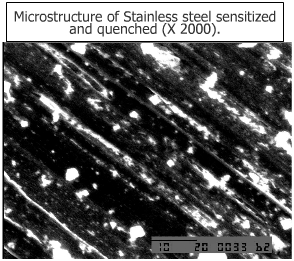Intergranular
Corrosion of Stabilized Grades of Steel
Surprising as it may seem, the
stabilized grades of steel (steels containing Cb or Ti) may also exhibit
intergranular attack under certain unfavorable conditions. The attack has been
termed as "knife line attack" because of the knife like appearance
in a very narrow band in the metal adjacent to the weld, whereas the weld
decay described in the previous section occurs at a greater distance from the
weld.
Mechanism
The temperature at the weld is of
the order of 1650 oC. Because of the contact with the weld, the
metal is also at a high temperature. Between the weld and the zone just next
to the metal, a thermal gradient exists because of the poor thermal
conductivity of the steel. If the temperature at the weld is around 1650 oC,
the temperature of the metal adjacent to the weld in the unmelted region would
be around 1425 oC. This region would contain all carbide in
solution and no carbides would precipitate. If, however, for some reason, the
metal is subjected to heating in the sensitizing temperature zone 510 - 780 oC,
it would fail because chromium carbide would be precipitated and not columbium
carbide, because of columbium carbide require a higher temperature. The steel
would, therefore, behave as if it contained no stabilizer added (columbium or
titanium) and is subjected to intergranular corrosion of the form of
knife-line attack.
Stainless steel AISI 321 above the
weld and stainless steel AISI 316 underneath the weld.
Above, right and along the weld
knife-line attack is seen, whereas below, at some distance from the weld, weld
decay and uniform attack is observed.
Remedy
Avoid any heat treatment which
causes temperature to be reached in the sensitizing range because chromium
carbides would immediately precipitated. heat the completed structure to about
1050 oC after welding to avoid knife-line attack.

Thanks for given detail information to me. keep posting like this. Intergranular Corrosion of Stabilized Grades of Steel
ReplyDelete